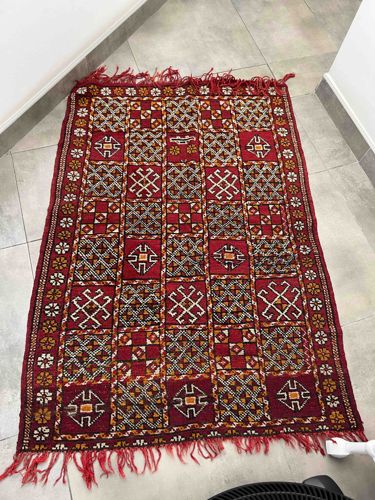
Traditional Geometric Patterned Area Rug
This item is a rectangular, hand-knotted or flat-woven area rug, likely a tribal or nomadic piece based on its intricate geometric patterns and rustic appearance. Its primary color is a deep, rich red, which serves as the background for a repeating grid of square motifs. Each square contains either a complex patterned design, often with star-like or fractal elements in white, dark brown/black, and gold/orange, or a central stylized cross or hook-shaped motif within a solid red square. The border of the rug features a repeating floral or geometric pattern in white and gold/orange against the same red background. The materials appear to be natural fibers, likely wool, given the texture and slight sheen visible in some areas. The construction suggests traditional methods, possibly hand-woven, as evidenced by the irregular nature of some patterns and the visible texture. Fringes are present on what appear to be the shorter ends of the rug, showing some wear and slight unraveling, which is consistent with age and use. The overall condition shows signs of use, including some minor fraying on the edges and fringes, and possibly some minor pile loss in heavily trafficked areas, though the vibrant colors suggest good preservation. The craftsmanship, while not uniformly precise, indicates a skilled artisan, typical of folk art or tribal textiles where slight variations add to the charm and individuality of the piece. The aesthetic points to a style period that could range from late 19th to mid-20th century, consistent with a traditional nomadic flatweave or pile rug from a region such as Anatolia, the Caucasus, or North Africa.
AI-Generated Appraisal Disclaimer
Estimated Value
$700-1,200
Basic Information
Category
Textiles and Rugs
Appraised On
December 8, 2025
Estimated Value
$700-1,200
Item Description
This item is a rectangular, hand-knotted or flat-woven area rug, likely a tribal or nomadic piece based on its intricate geometric patterns and rustic appearance. Its primary color is a deep, rich red, which serves as the background for a repeating grid of square motifs. Each square contains either a complex patterned design, often with star-like or fractal elements in white, dark brown/black, and gold/orange, or a central stylized cross or hook-shaped motif within a solid red square. The border of the rug features a repeating floral or geometric pattern in white and gold/orange against the same red background. The materials appear to be natural fibers, likely wool, given the texture and slight sheen visible in some areas. The construction suggests traditional methods, possibly hand-woven, as evidenced by the irregular nature of some patterns and the visible texture. Fringes are present on what appear to be the shorter ends of the rug, showing some wear and slight unraveling, which is consistent with age and use. The overall condition shows signs of use, including some minor fraying on the edges and fringes, and possibly some minor pile loss in heavily trafficked areas, though the vibrant colors suggest good preservation. The craftsmanship, while not uniformly precise, indicates a skilled artisan, typical of folk art or tribal textiles where slight variations add to the charm and individuality of the piece. The aesthetic points to a style period that could range from late 19th to mid-20th century, consistent with a traditional nomadic flatweave or pile rug from a region such as Anatolia, the Caucasus, or North Africa.
Related Tags
Get Your Items Appraised
Instant estimates of your treasures with AI-powered instant appraisals